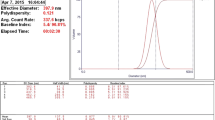Summary
The most effective sequence of small interfering RNA (siRNA) silencing STAT3 of psoriatic keratinocytes (KCs) was screened out, and the effects of the most effective siRNA combined with ultrasonic irradiation and SonoVue microbubbles on the expression of STAT3 of KCs and the dose- and time-response were investigated. Three chemically-synthetic siRNAs targeting STAT3 carried by Lipofectamine 3000 were transfected into KCs, and the effects on STAT3 expression were detected, then the most effective siRNA was selected for the subsequent experiments. The negative controls of siRNA (siRNA-NC) labeled with Cy3 carried by Lipofectamine 3000 combined with ultrasonic irradiation and SonoVue microbubbles were transfected into KCs, then the optimal parameters of ultrasonic irradiation were determined. The most effective siRNA carried by Li-pofectamine 3000 combined with ultrasonic irradiation at the optimal parameters and SonoVue microbubbles was transfected into KCs, and the dose- and time-response of RNA interference was determined. The effect of RNA interference by the most effective siRNA at the optimal time and dose carried by Lipofectamine 3000 combined with ultrasonic irradiation and SonoVue microbubbles (LUS group) was compared with that only carried by Li-pofectamine 3000 (L group). The results showed that siRNA-3 achieved the highest silencing efficacy. 0.5 W/cm2 and 30 s were selected as the parameters of ultrasonic irradiation. The siRNA-3 carried by Lipofectamine 3000 combined with ultrasonic irradiation and SonoVue microbubbles could effectively knock down the STAT3 expression at mRNA and protein levels in dose- and time-dependent manners determined at 100 nmol/L with maximum downregulation on mRNA at 48 h, and on protein at 72 h after transfection. The LUS group achieved the highest silencing efficacy. It was concluded that siRNA-3 carried by Lipofectamine 3000 combined with ultrasonic irradiation and SonoVue microbubbles could effectively knock down the STAT3 expression in psoriatic KCs, and the optimized transfection condition and the sequence of siRNA-3 could serve for further research on gene therapy of psoriasis.
Similar content being viewed by others
References
Lovato P, Norsgaard H, Tokura Y, et al. Calcipotriol and betamethasone dipropionate exert additive inhibitory effects on the cytokine expression of inflammatory dendritic cell-Th17 cell axis in psoriasis. J Dermatol Sci, 2016,81(3):153–164
Bracke S, Desmet E, Guerrero-Aspizua S, et al. Identifying targets for topical RNAi therapeutics in psoriasis: assessment of a new in vitro psoriasis model. Arch Dermatol Res, 2013,305(6):501–512
Nakajima K, Kanda T, Takaishi M, et al. Distinct roles of IL-23 and IL-17 in the development of psoriasis-like lesions in a mouse model. J Immunol, 2011,186(7):4481–4489
Andrés RM, Montesinos MC, Navalón P, et al. NF-kB and STAT3 inhibition as a therapeutic strategy in psoriasis: in vitro and in vivo effects of BTH. J Invest Dermatol, 2013,133(10):2362–2371
Johansen C, Mose M, Ommen P, et al. IB is a key driver in the development of psoriasis. Proc Natl Acad Sci USA, 2015, 112(43):E5825–5833
Miyoshi K, Takaishi M, Nakajima K, et al. Stat3 as a therapeutic target for the treatment of psoriasis: a clinical feasibility study with STA-21, a Stat3 inhibitor. J Invest Dermatol, 2011,131(1):108–117
Shi X, Jin L, Dang E, et al. IL-17A upregulates keratin 17 expression in keratinocytes through STAT1-and STAT3-dependent mechanisms. J Invest Dermatol, 2011,131(12):2401–2408
Moriwaki Y, Takada K, Nagasaki T, et al. IL-22/STAT3-induced increases in slurp1 expression within psoriatic lesions exerts antimicrobial effects against Staphylococcus aureus. PLoS One, 2015,10(10):e0140750
Keren A, David M, Gilhar A. Novel nanosome delivery system combined with siRNA targeting the antimicrobial gene DFB4: a new approach for psoriasis management?. Exp Dermatol, 2014,23(7):464–465
Lee H, Morales LD, Slaga TJ, et al. Activation of T-cell protein-tyrosine phosphatase suppresses keratinocyte survival and proliferation following UVB irradiation. J Biol Chem, 2015,290(1):13–24
Chang T, Sun L, Wang Y, et al. Inhibition of keratin 17 expression with antisense and RNAi strategies: exploring novel therapy for psoriasis. Exp Dermatol, 2011,20(7):555–560
Honma M, Minami-Hori M, Takahashi H, et al. Podoplanin expreßsion in wound and hyperproliferative psoriatic epidermis: regulation by TGF-ß and STAT-3 activating cytokines, IFN-?, IL-6, and IL-22. J Dermatol Sci, 2012,65(2):134–140
Wang JJ, Zheng Y, Yang F, et al. Survivin small interfering RNA transfected with a microbubble and ultrasound exposure inducing apoptosis in ovarian carcinoma cells. Int J Gynecol Cancer, 2010,20(4):500–506
Tong HP, Wang LF, Guo YL, et al. Preparation of protamine cationic nanobubbles and experimental study of their physical properties and in vivo contrast enhancement. Ultrasound Med Biol, 2013,39(11):2147–2157
Nie F, Wang XF, Zhao SY, et al. Gene silencing of Rac1 with RNA interference mediated by ultrasound and microbubbles in human LoVo cells: evaluation of cell invasion inhibition and metastatic. J Drug Target, 2015,23(4):380–386
Han X, Cheng W, Jing H, et al. Neuroepithelial transforming protein 1 short interfering RNA-mediated gene silencing with microbubble and ultrasound exposure inhibits the proliferation of hepatic carcinoma cells in vitro. J Ultrasound Med, 2012,31(6):853–861
Irie N, Sakai N, Ueyama T, et al. Subtype-and species-specific knockdown of PKC using short interfering RNA. Biochem Biophys Res Commun, 2002,298(5):738–743
Author information
Authors and Affiliations
Corresponding author
Additional information
This project was supported by National Natural Science Foundation of China (No. 81441126).
Rights and permissions
About this article
Cite this article
Ran, Lw., Wang, H., Lan, D. et al. Effects of RNA interference combined with ultrasonic irradiation and SonoVue microbubbles on expression of STAT3 gene in keratinocytes of psoriatic lesions. J. Huazhong Univ. Sci. Technol. [Med. Sci.] 37, 279–285 (2017). https://doi.org/10.1007/s11596-017-1728-6
Received:
Revised:
Published:
Issue Date:
DOI: https://doi.org/10.1007/s11596-017-1728-6




